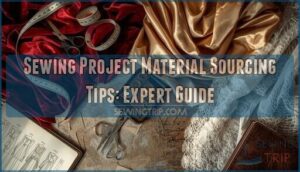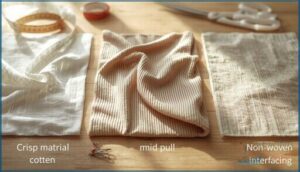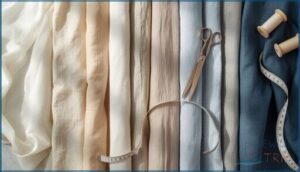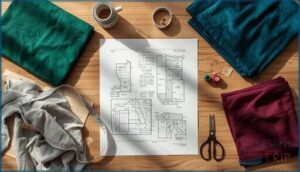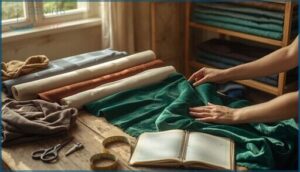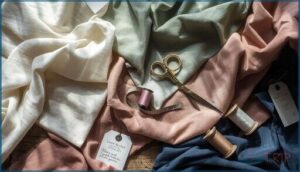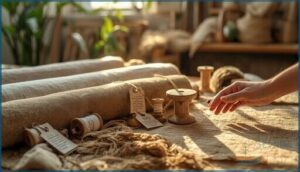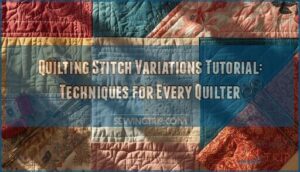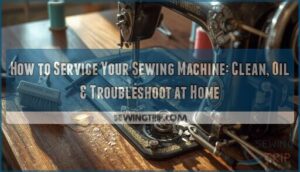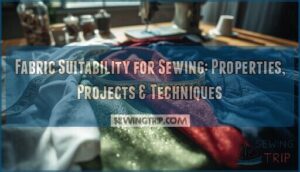This site is supported by our readers. We may earn a commission, at no cost to you, if you purchase through links.
The wrong fabric can turn your dream garment into a wearable nightmare, no matter how perfectly you execute the stitching. That’s the brutal reality of sewing project material sourcing—one miscalculation in weight, drape, or fiber content transforms hours of careful work into something that hangs awkwardly or falls apart after the first wash.
Yet many sewers approach fabric selection like shopping for groceries, grabbing whatever looks appealing without considering structure, maintenance requirements, or supplier reliability. Smart material sourcing isn’t just about finding beautiful textiles; it’s about matching technical specifications to your project’s demands while addressing costs, sustainability concerns, and the often-confusing landscape of mills, converters, and jobbers.
Master these fundamentals, and you’ll consistently source materials that bring your creative vision to life.
Table Of Contents
- Key Takeaways
- Key Factors in Fabric Selection
- Types of Fabrics and Their Properties
- Sourcing Fabric: Step-by-Step Process
- Choosing The Right Fabric Suppliers
- Navigating Fabric Costs and Quality
- Ensuring Sustainable and Ethical Sourcing
- Common Sourcing Mistakes to Avoid
- Expert Tips for Successful Material Sourcing
- Frequently Asked Questions (FAQs)
- Conclusion
Key Takeaways
- Matching fabric weight, drape, and fiber content to your pattern’s technical requirements prevents fit disasters and wasted materials, with 78% of professional designers starting every project with a detailed requirements analysis before sourcing.
- Building long-term relationships with verified suppliers who hold certifications like GOTS or OEKO-TEX cuts sourcing costs by 15%, reduces delivery delays by 23%, and gives you priority access to quality materials and market insights.
- Testing swatches for shrinkage, colorfastness, and drape before bulk ordering prevents the 87% of fabric disputes that get resolved at the sample stage, saving you from expensive mistakes and project failures.
- Sustainable sourcing isn’t just ethical—organic cotton produces 94 kg CO2e per 1,000 square meters compared to conventional cotton’s 1,661 kg, proving you can reduce environmental impact while maintaining material quality.
Key Factors in Fabric Selection
Picking the right fabric for your project isn’t just about what looks good—it’s about making choices that actually work for what you’re creating. Before you start hunting for materials, you need to understand a few key factors that’ll guide every decision you make.
Let’s walk through the essentials that separate a solid fabric choice from one that’ll give you trouble down the line.
Understanding Project Requirements
Before you hunt for fabric, nail down what your project actually needs. Seventy-eight percent of professional designers begin by conducting a project-specific requirements analysis. Start by asking yourself three critical questions:
- What’s the intended use—will this garment see heavy wear, or is it decorative?
- What performance needs matter most—stretch, durability, breathability, or water resistance?
- What are your budget constraints and user expectations for care and longevity?
Considering the fabric’s technical specifications is also key for ensuring it meets the project’s demands. This upfront work prevents costly mistakes down the road, saving you time and money.
Matching Fabric to Design and Pattern
Now that you’ve defined your project requirements, the next step is matching your fabric choice to your actual pattern. Over 80% of commercial patterns include specific fabric recommendations on the envelope—and there’s good reason for that. Pattern fabric compatibility matters because the wrong choice can shift how your garment fits and performs. When sewists follow these recommendations, garment success rates jump by 24%.
Think of it this way: a flowing dress pattern designed for lightweight cotton will look completely different in stiff denim. The fabric’s structure, weight, and drape directly impact seam efficiency and final appearance. Cotton fabrics, for instance, deliver the highest seam efficiency at 53.3%, while silk performs considerably lower due to frictional differences.
Your pattern assumes specific fabric properties. Structured garments commonly call for medium- to heavy-weight woven fabrics 68% of the time to maintain their intended shape. Conversely, designs requiring gathers or flare specify lightweight fabrics in 89% of patterns, allowing proper flow.
Before cutting, visualize how your chosen fabric will actually drape in 3D. This simple step reduces pattern mismatch errors by 18%. Better yet, test-sew a quick sample in your selected fabric. Garments constructed after sampling multiple options see a 23% boost in user satisfaction—because you’ll catch fit issues before they become costly mistakes. Many patterns also include finished garment measurements on the pattern envelope.
| Pattern Type | Recommended Weight | Best Fabric Types | Seam Efficiency | Key Consideration |
|---|---|---|---|---|
| Structured (blazers, shirts) | Medium to heavy | Woven cotton, wool blends | 53.3% | Maintains shape and structure |
| Flowing (dresses, skirts) | Lightweight | Silk, cotton voile, linen | Lower but allows drape | movement and gathers |
| Fitted (bodycon, athletic) | Stretch or knit | Cotton-spandex blends, jersey | Variable | comfort and recovery |
| Casual (t-shirts, basics) | Medium | Cotton knit, jersey | Moderate | Balanced durability and comfort |
| Formal (gowns, evening wear) | Varies by design | Silk, |
Evaluating Fabric Weight and Drape
Now that you’ve matched your pattern to a fabric type, weight becomes your next critical decision. Fabric weight—measured in GSM (grams per square meter) or oz/sqyd—directly controls how your garment drapes and performs. Lightweight fabrics under 160 GSM create fluid movement, while medium-weight options (170–230 GSM) balance structure with comfort. Heavy fabrics above 300 GSM provide rigidity ideal for outerwear.
Consider these factors:
- Your climate and season—tropical regions favor breathable, lighter weights; cold climates need 400+ GSM wools
- Desired silhouette—flowing designs need lower GSM; structured pieces require heavier fabrics
- Fiber type—finer fibers drape better regardless of weight
Test swatches before committing.
Considering Fabric Durability and Maintenance
Weight and drape matter, but durability is where your investment truly pays off. Consumers expect clothing to withstand at least 50 washes, yet many fabrics fail after just 15–20. Before you commit to any material, consider its fabric longevity and care instructions.
Cotton blends outperform pure synthetics in abrasion resistance, while polyester tolerates aggressive washing better. Test swatches for shrinkage and colorfastness. Material testing now prevents costly mistakes later.
Your fabric choice directly impacts maintenance costs and customer satisfaction down the line.
Types of Fabrics and Their Properties
Before you can source the right fabric for your project, you need to know what’s actually available and how different fabrics behave. Understanding the basics—what makes one fabric stretchy, another durable, or a third absorbent—changes everything about your material choices.
Let’s look at the main fabric types and what each one brings to your work.
Woven, Knit, and Non-Woven Fabrics
The fabric you choose fundamentally shapes your project’s success. Understanding the three basic fabric types—woven, knit, and non-woven—helps you select materials that truly work for your design.
Each construction method creates distinct properties:
- Woven fabrics interlace two yarn systems at right angles, delivering strength and dimensional stability for structured garments
- Knit fabrics inter-loop yarns, offering natural stretch and recovery ideal for fitted, flexible pieces
- Non-woven fabrics bond fibers through heat or chemicals, engineered for specific performance needs
- Weave patterns and knit structures directly influence how fabric drapes, moves, and wears over time
Matching fabric construction to your pattern requirements prevents costly mistakes down the line.
Natural Vs Synthetic Fibers
Between natural and synthetic fibers, you’re largely choosing between two different material philosophies. Synthetic fibers like polyester dominate today’s market at 73.4% of global production, offering durability, affordability, and low maintenance. Natural fibers—cotton, linen, silk—cost more but biodegrade rapidly and regulate moisture.
Synthetic production relies on fossil fuels, while natural cultivation demands water. Your fiber choice shapes both your project’s longevity and environmental footprint, so weigh sourcing materials against your design priorities.
Fabric Characteristics and Best Uses
Your fabric choice determines how your project performs and ages. Here’s what separates a good selection from a great one:
- Lightweight fabrics (2–3 oz/sq yd): voile, crepe, chiffon for flowing garments
- Medium-weight (6–8 oz/sq yd): trousers, jackets, structured pieces
- Heavy-duty (9–12 oz/sq yd): denim, twill, workwear
- Weight affects drape coefficient—finer yarns create better flow than coarse ones
- Maintenance needs vary: polyester resists wrinkles; linen demands care
Match fiber durability to your design’s demands. Synthetics outlast naturals in workwear; cotton breathes better for everyday wear. Understanding these trade-offs ensures project suitability and lasting quality.
Sourcing Fabric: Step-by-Step Process
Finding the right fabric starts with knowing exactly what you need—and that’s where a clear process makes all the difference. Rather than hunting randomly or second-guessing yourself later, you’ll work through three straightforward steps that cover everything from calculating quantities to matching your fabric to your pattern.
Let’s walk through each one.
Defining Material Needs and Quantities
Getting your fabric quantities right from the start saves headaches later. Start by analyzing your pattern—it’ll specify fabric requirements based on garment size and intended fabric width, which can vary by up to 30% between sizes.
Factor in your fabric length, seam allowances, and a 3–5% shrinkage margin. Don’t forget that fabric width directly impacts yardage needed; standard widths range from 110–150 cm.
For complex patterns or directional prints, add 10–20% extra to your material list to cover cutting layouts and potential matching needs.
Collecting Swatches and Samples
Before committing to bulk fabric orders, you need to hold swatches in your hands. Request 4×4 inch samples across colorways from mills, converters, and online platforms—this standard size balances detail and handling.
Evaluate handfeel, texture, and weight under natural light. Lay swatches side by side to compare tones and weaves.
Order production samples directly from manufacturing batches to verify consistency before finalizing your order.
Aligning Fabric Width With Pattern Layout
Here’s where fabric width becomes your secret tool for efficiency. Standard apparel fabrics run 44–45 inches wide, but wider options at 54–60 inches let you nest more pattern pieces across the width, cutting yardage needs and waste substantially.
Measure your pattern pieces first, then match them against available widths—this simple alignment step reduces cutting time by roughly 25% and prevents costly shortages. Wider fabrics accommodate pattern repeats better too, keeping your design intact without truncation or forced layout changes.
Choosing The Right Fabric Suppliers
Now that you’ve figured out what fabric you need, the real work begins—finding the right place to buy it. There are several types of suppliers out there, each with different strengths depending on your project size and what you’re looking for.
Let’s walk through your main options so you can pick the best fit for your needs.
Mills, Converters, Jobbers, and Agents
When sourcing fabric, you’ll encounter four main supplier types, each serving different needs. Textile mills require substantial minimums—often thousands of yards—but offer continuity and control. Converters provide greater flexibility with lower minimums, usually several hundred yards, ideal for fashion-forward colors and finishes. Jobbers sell deadstock and overruns at reduced prices with minimal commitments, though reorders aren’t guaranteed. Sourcing agents charge 5–10% commissions to manage multiple suppliers across regions.
Most successful projects use hybrid sourcing: mills for core fabrics, converters for seasonal pieces, and jobbers for experimental batches.
Evaluating Supplier Reliability and Certifications
After narrowing down supplier types, you need to verify who you’re working with. Nearly 90% of fashion companies now map their supply chains, and for good reason—supplier performance directly impacts your project’s success.
Look for fabric certifications like GOTS or OEKO-TEX, which signal environmental standards and ethical sourcing. Third-party audit compliance became standard in 2024, with major brands requiring annual checks for traceability tech, risk mitigation, and supply chain transparency.
Certifications aren’t just paperwork—they open doors and reduce headaches down the line.
Sourcing at Trade Shows and Online Platforms
Once you’ve confirmed supplier reliability, it’s time to actually find and meet them. Trade shows like ITMA 2023 drew over 111,000 visitors from 143 countries, offering unparalleled face-to-face access—though booth costs and travel can push expenses past $10,000.
Online platforms from Alibaba to Material Exchange let you filter by certifications, compare MOQs, and cut lead times without leaving your workspace.
Tips for Contacting and Negotiating With Suppliers
After you’ve researched suppliers online or in person, your initial contact sets the tone. Be clear about your fabric sourcing needs—specify quantities, timeline, and quality standards. Ask for pricing transparency and MOQ flexibility upfront.
When you negotiate pricing, mention your willingness to scale orders for volume discounts. Building supplier relationships through consistent communication and reliable payment earns you better terms over time.
Navigating Fabric Costs and Quality
Finding the right fabric at the right price can feel like walking a tightrope between your budget and your vision. You need to understand how suppliers price their materials, what drives those costs, and where you can make smart trade-offs without sacrificing quality.
Let’s break down the key factors that’ll help you source fabrics strategically and avoid costly mistakes along the way.
Understanding Pricing Structures and Minimums
Fabric cost isn’t as straightforward as you’d think—pricing structures hinge on volume thresholds, regional markets, and contract terms. To navigate this confidently:
- Minimum Order Quantity (MOQ) generally runs 200–2,000 yards, varying by mill location and fiber type
- Tiered pricing cuts unit costs 10–25% at bulk thresholds
- Volume discounts reward larger commitments with substantial savings
- Sourcing region affects prices—domestic commands premiums, offshore reduces material expenses
- Contract clauses stabilize costs through fixed-rate agreements or commodity-indexed escalations
Smart MOQ negotiation unlocks better rates without overcommitting inventory.
Balancing Cost, Quality, and Shipping
When you’re juggling fabric sourcing decisions, cost alone won’t tell the full story. Quality cotton can range from $10 to $30 per yard, and overseas shipping might add $500 to $2,000 per order—numbers that shift your budget fast.
Strategic cost tradeoffs mean testing fabric durability before committing, checking supplier certifications to cut risk by 23%, and planning for lead time delays that averaged 21% longer during peak seasons.
Ordering in Bulk Vs Small Quantities
Choosing between bulk and small orders depends on your timeline and budget tolerance. Bulk orders slash per-yard costs by 15–30% and meet minimum order quantity (MOQ) thresholds of 50–100 yards for wholesale rates.
Small batch runs—often 5–10 yards—let you test sample yardage before committing, though you’ll pay triple per yard.
Hybrid sourcing balances cost savings with supply chain optimization.
Identifying and Avoiding Deadstock Issues
Deadstock fabrics sound like a bargain—leftover rolls at discount prices—but traceability challenges and continuity risks can sabotage your project.
These lots often lack certificates proving fiber content or chemical safety, making quality control nearly impossible. Worse, once that yardage sells out, you can’t reorder.
Before committing, request swatches for test washes and reserve deadstock for one-off capsules, not core styles.
Ensuring Sustainable and Ethical Sourcing
Sourcing fabric isn’t just about finding the right texture or price—it’s also about understanding where your materials come from and how they’re made. The choices you make can reduce environmental harm, support fair wages, and align your work with values that matter.
Here’s what to think about when you want your sourcing decisions to reflect responsibility alongside quality.
Environmental Impact of Fabric Choices
Your fabric choices ripple far beyond the cutting table. The environmental impact of textiles spans fiber carbon footprint, water usage, and chemical pollution, with conventional cotton emitting 1,661 kg CO2e per 1,000 square meters compared to organic cotton’s mere 94 kg.
Natural vs synthetic fibers present distinct tradeoffs:
- Polyester demands 125 megajoules per kilogram and sheds persistent microplastics
- Organic cotton slashes blue water consumption by 91% over conventional methods
- Textile waste accounts for nearly 6% of U.S. municipal solid waste annually
Sustainable alternatives in sustainable textile production reduce your project’s footprint while maintaining quality.
Recognizing Sustainability Certifications (GOTS, OEKO-TEX, Bluesign)
Three trusted certifications cut through greenwashing claims in sustainable fabrics. GOTS (Global Organic Textile Standard) verifies organic fiber content across 15,441 facilities worldwide, with India leading at over 4,000 certified sites. OEKO-TEX issued 57,000 certificates in 2024, banning harmful chemicals while improving consumer awareness. Bluesign targets chemical reduction, with partners cutting CO₂ emissions by 17%.
These fabric certifications and standards offer comparative analysis of ethical fabric choices, ensuring certification benefits through rigorous global standards and future trends in textile accountability.
Considering Fair Labor Practices
Beyond certifications, fair labor practices shape responsible fabric sourcing decisions. Only 2% of garment workers earn living wages, and 85% of U.S. factories showed violations like paying just 3 cents per piece.
Fair labor practices matter because only 2% of garment workers earn living wages, and most U.S. factories violate labor standards
When evaluating supply chains, ask suppliers about worker welfare, child labor prevention, and Fair Trade certification. Ethical fabric choices mean verifying worker safety standards, not just accepting audit reports—especially since disasters occurred in “certified” facilities.
Supporting Local and Eco-Friendly Options
Choosing locally produced fabrics cuts transportation emissions while supporting regional economies—a win for both sustainability and your community. By 2025, proximity matters: 61% of quilters shop within 30 minutes of home, and local sourcing strengthens supply chain transparency.
Look for eco-innovation like hemp or upcycled materials alongside ethical certifications. Your consumer preferences drive brands toward responsible fabric sourcing, making sustainable textiles and eco-friendly fabrics more accessible than ever.
Common Sourcing Mistakes to Avoid
Even seasoned sewists stumble into sourcing pitfalls that can derail an entire project before the first stitch hits fabric. These missteps often stem from working too fast, skipping verification steps, or simply not knowing what red flags to watch for.
Here are the most common sourcing mistakes you’ll want to steer clear of.
Relying on Unverified Suppliers
When fabric suppliers lack verification, counterfeit prevalence rises, threatening both fabric quality and the fabric sourcing process. Evaluating fabric quality becomes nearly impossible, and financial impacts multiply—delays disrupt your supply chain, while ethical issues like labor violations tarnish your brand.
The fabric sourcing process demands suppliers with proven certifications, transparent practices, and consistent reliability to protect your project from costly, avoidable mistakes.
Ignoring Fabric Care and Maintenance Needs
Overlooking care instructions sets you up for disappointment—up to 10% shrinkage issues can wreck garment fit, while color fading affects 18% of improperly treated textiles.
Ignoring maintenance accelerates durability decline by nearly 50%, and texture changes make your work unwearable.
The economic impact hits hard: fabric care failures cost the industry over $460 million yearly, turning promising projects into expensive lessons.
Misjudging Fabric Quantities and Specifications
When you eyeball measurements instead of calculating precisely, you join the 29% who miscalculate fabric needs. Spec misjudgments cause dimension distortions in 30% of projects, while ignoring fabric width in layout planning wastes material in 28% of cases.
Quantity calculation errors and sourcing mistakes stem from skipping pre-wash tests and conversion checks.
Preventive measures include testing swatches, adding two-inch margins, and matching fabric properties to pattern requirements.
Expert Tips for Successful Material Sourcing
You’ve learned what to avoid—now let’s focus on what actually works. Successful material sourcing isn’t just about finding the right fabric; it’s about building systems and relationships that make every project smoother.
These four strategies will help you source smarter, work more efficiently, and set yourself up for long-term success.
Working With Pattern Makers for Efficiency
Pattern makers bring more than technical drafting skills to fabric sourcing and material selection. When you involve them early, they use data analytics to improve marker efficiency, often hitting 80–85% benchmarks that reduce waste and cutting costs.
Their 3D integration tools preview drape before ordering, while error reduction through precise pattern work shortens lead-time efficiency and prevents costly missteps in fabric properties and fabric selection for clothing lines.
Keeping Detailed Fabric Records
Digital Record-Keeping transforms how you track fabrics and reduces wastage considerably. Log fabric weight, fabric properties, supplier information, and attach swatches to each entry—businesses see 78% fewer production errors with this approach. Include textiles’ width, composition, and batch numbers.
Quarterly Inventory Audits cut discrepancies by 54%, while organized Swatch Organization with photos boosts identification accuracy by 63%, sharpening your material decisions.
Staying Updated on Market Trends and Innovations
You won’t source winning fabrics if you’re stuck in yesterday’s methods. The global textile market is racing toward $4.02 trillion by 2034, and AI fabric sourcing, digital textile printing, and smart textile innovations are reshaping what’s available.
- Subscribe to textile industry newsletters tracking sustainable textile growth and sustainable materials
- Attend virtual trade shows showcasing customization technologies
- Follow fabric suppliers on LinkedIn for market traction updates
- Test emerging bio-based options gaining momentum
Building Long-Term Supplier Relationships
Your best fabric suppliers aren’t one-time transactions—they’re partners who grow with you. Over 80% of major apparel brands prioritize strategic partnerships because long-term relationships slash sourcing costs by 15% and cut delivery delays by 23%. Supplier communication builds trust, enabling collaborative innovation and quality consistency while strengthening ethical alignment.
| Relationship Benefit | Impact on Your Sourcing |
|---|---|
| Negotiate pricing terms favorably | 8% average cost advantage |
| Quality consistency improvements | 21% fewer defect returns |
| Risk mitigation capabilities | 28% better disruption resilience |
| Faster lead times | 12 weeks vs. 18 weeks average |
| Collaborative innovation access | 19% more new materials adopted |
Regular performance reviews with fabric suppliers keep both parties accountable. Track delivery speed, fabric quality, and responsiveness—52% of procurement teams formally measure these through Supplier Relationship Index scores. When you invest time in understanding your supplier’s capabilities and constraints, they’ll prioritize your orders and alert you to market shifts before competitors catch on.
Frequently Asked Questions (FAQs)
How do I test fabric before buying large quantities?
Before placing bulk orders, 87% of disputes get resolved at the swatch stage.
Request physical swatches, then conduct shrinkage testing, colorfastness tests, and visual inspection.
Evaluate tensile strength, seam slippage, and burn test samples yourself.
What are fabric lead times for international orders?
When you place international fabric orders, expect lead times of 20 to 35 days under normal conditions.
Shipping transit, supplier effects, and variability drivers like port congestion all influence the end-to-end order cycle and fabric delivery lead time.
Can I return or exchange unsuitable fabric purchases?
Return policies vary widely across fabric stores—online returns average 6% for textiles. Your legal rights depend on the retailer’s terms, so review exchange trends and return reasons before ordering.
How do I store fabric to prevent damage?
Store fabric in opaque containers away from light exposure to prevent fading. Maintain humidity control between 45-50%, use acid-free boxes for container selection, add cedar for pest prevention, and roll fabrics during storage handling to avoid permanent creases.
What minimum orders do fabric suppliers typically require?
Fabric suppliers generally require minimum order quantities (MOQ) ranging from 1 meter on flexible online platforms to 500-1,000 meters from mills.
Sample yardage starts around 5 yards, and supplier variations affect small businesses differently.
Conclusion
A rushed fabric purchase at midnight versus a strategic sourcing decision made with swatches, certifications, and supplier conversations—the difference transforms your entire sewing experience.
Smart sewing project material sourcing tips aren’t about flawlessness; they’re about building a framework that consistently delivers quality results.
You now understand how fiber content, supplier relationships, and sustainability intersect. Apply this knowledge deliberately, document your wins and missteps, and watch your projects evolve from hopeful experiments into predictable successes.
- https://bestcolorfulsocks.com/blogs/news/global-fabric-sourcing-statistics
- https://www.shopify.com/blog/how-to-source-fabric
- https://www.textileworld.com/textile-world/2024/12/textile-supply-chain-trends-of-2024-and-predictions-for-2025/
- https://shenglufashion.com/2022/12/20/new-study-explore-u-s-retailers-sourcing-strategies-for-clothing-made-from-recycled-textile-materials/
- https://likesew.com/blog/sewing-trends

